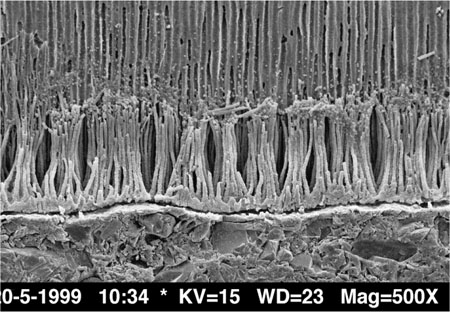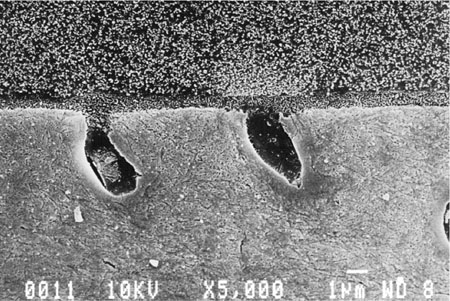Chapter 2
Adhesion and the Root-filled Tooth
Aim
To address:
-
Principles of adhesion to the dentine of root canal treated teeth.
-
Mechanical and chemical interferences with adhesion and how to overcome them.
-
The properties of the different bonding systems for the restoration of root canal treated teeth.
Outcome
At the end of this chapter, the reader should be able to identify the issues which must be considered for successful adhesive restoration of root canal treated teeth.
Background to Contemporary Adhesive Systems
Based upon the underlying mechanism of action, contemporary adhesive systems can be divided into:
-
etch-and-rinse adhesives
-
self-etching adhesives
-
glass-ionomer systems.
If consideration is given to the number of steps needed to obtain adhesion to dentine, adhesive systems may be classified as three-step, two-step or one-step. Dentine bonding systems will be described according to this classification.
Three-step Systems
Three-step systems include:
-
Etching dentine with phosphoric acid (32–37%) to remove smear layer, open dentinal tubules and expose collagen fibres on the dentine surface.
-
Priming dentine with an hydrophilic solution containing alcohol, water or acetone and resin to establish a preliminary link to the dentinal collagen.
-
Application of an adhesive, methacrylate-based resin that will connect the subsequently applied composite resin to the pre-impregnated dentinal surface (Fig 2-1).

Fig 2-1 Intracanal section showing the resin-dentine interdiffusion zone created by a three-step adhesive system.
This procedure results in the formation of an acid-resistant, resin-infiltrated collagen layer (hybrid layer) that ensures, together with the penetration of the resin into the dentinal tubules, good bonding of the composite to the dentine.
After the initial etching phase, a 30 s rinse with water is always indicated, followed by gentle air drying of the surface. Complete desiccation of the dentine causes the exposed collagen fibres to collapse, and compromises their ability to interact with the bonding resin. Therefore, the dentine surface should remain moist to ensure that collagen fibres remain in an erect, hydrated state for optimal interaction and adhesion.
Two-step Systems
Two-step systems include:
-
A refined version of the three-step system, in which a “one bottle” adhesive consisting of a combined primer and adhesive is applied after tooth preparation and etching.
Step 1: total etching with phosphoric acid, rinsing with water and gentle drying, as for three-step systems.
Step 2: application of the combined primer and adhesive.
-
Self-etching adhesives
An acidic primer partially dissolves and infiltrates the smear layer and a methacrylic resin that links the primer to the composite resin restorative or luting cement is then applied (Fig 2-2).Step 1: application of a self-etching primer.
Step 2: application of adhesive.
-
Glass-ionomer systems.
Glass-ionomer cements bond to dentine by mechanical and chemical means. Dentine is usually pretreated with polyalkenoic acid to remove the smear layer and expose collagen fibrils to a depth of 0.5–1.0 μm. Interdiffusion with components of the glass-ionomer cement develops micromechanical adhesion by the principle of hybridisation. In addition, chemical bonding is obtained by ionic interaction of the carboxyl groups of the polyalkenoic acid with calcium ions of the hydroxyapatite which remained attached to the collagen fibrils. This additional chemical adhesion may be beneficial in terms of resistance to hydrolytic degradation. Consequently, a two-fold bonding mechanism is established, similar to that mentioned above for mild self-etch adhesives. The basic difference with the resin-based self-etch approach is that glass ionomers are self-etching through the use of a relatively high-molecular-weight (from 8000 to 15,000) polycarboxyl-base polymer. This limits their infiltration capacity, so that the hybrid layers formed are thinner than those created by the other adhesive types.

Fig 2-2 The resin-dentine interdiffusion zone created by a self-etching adhesive system.
One-step Systems
-
An innovation in which etchant, primer and adhesive are contained in a single solution.
Anatomical Considerations in Adhesion to Root Canal Dentine
Stay updated, free dental videos. Join our Telegram channel

VIDEdental - Online dental courses


